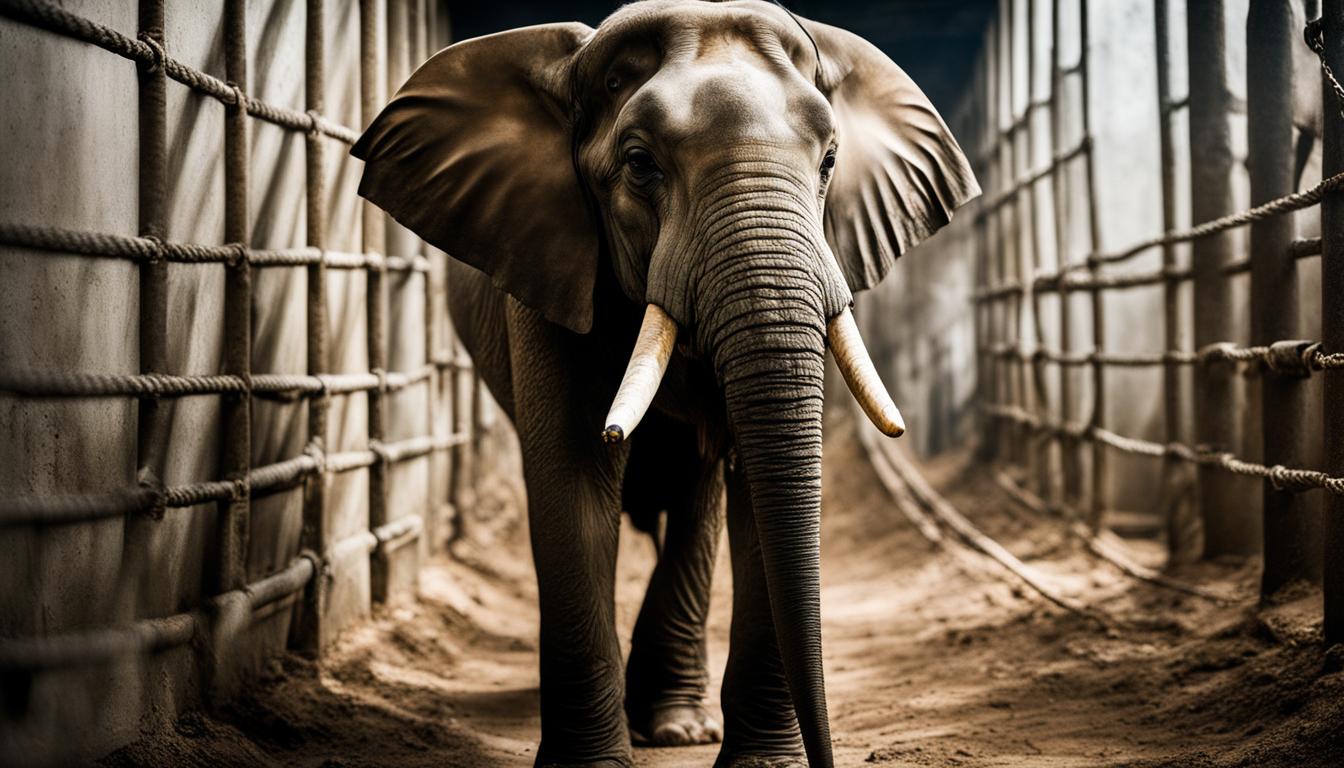In this article, we will explore the challenges faced by elephants in captivity and the impact it has on their welfare. The well-being of captive elephants is a subject of concern, as their lives differ significantly from their wild counterparts. From shortened lifespans to chronic health problems, elephants in captivity encounter numerous issues that raise important questions about their treatment and conservation.
When elephants are held captive, their average lifespan is significantly reduced compared to those in the wild. Foot disease is a major contributor to their early demise, leading to systemic infections and joint problems. The limited space and inadequate habitats in zoos pose significant challenges, even with efforts to improve living conditions.
Fortunately, elephant sanctuaries such as the Performing Animal Welfare Society (PAWS) and The Elephant Sanctuary in Tennessee (TES) have demonstrated the potential for sanctuary life to greatly improve an elephant’s well-being and add years to their projected longevity. These sanctuaries alleviate the fear and psychological burdens faced by captive elephants, providing them with a more natural and enriching environment.
Through this article, we will delve into the social and emotional challenges faced by captive elephants, the toll captivity takes on their physical health, the abuse and mistreatment they endure, and explore potential solutions for their future. Join us as we shed light on the complex issue of elephant welfare in captivity.
The Social and Emotional Challenges of Captive Elephants
Elephants in captivity face several challenges due to the inability to meet their complex social and emotional needs. In the wild, elephants live in large family units and have constant companionship, mourning the loss of family members and forming intricate social networks. However, in captivity, elephants are forced to live in artificial social units, often alone or in small groups, and the bonds they form are frequently broken due to shuffling between facilities. This lack of socialization and companionship deeply impacts the well-being of captive elephants.
Elephant sanctuaries and responsible elephant tourism initiatives offer a more ethical and compassionate alternative, allowing elephants to live in the company of their own kind and engage in natural behaviors. These sanctuaries prioritize the creation of social structures that mirror those found in the wild, providing elephants with the opportunity to form meaningful relationships and engage in natural social behaviors. The presence of conspecifics reduces stress and promotes overall well-being, allowing captive elephants to experience a higher quality of life.
By providing ample space and opportunities for social interaction, sanctuaries enable elephants to engage in activities such as grooming, playing, and communicating, all of which are vital for their emotional and cognitive development. The positive impacts of residing in a sanctuary-like environment are evident in the observed behavioral changes and improved overall welfare of the elephants that transition from captivity to these places of refuge.
These sanctuaries not only address the social and emotional needs of captive elephants but also educate visitors about responsible elephant tourism. By providing opportunities for up-close encounters with elephants in a natural and respectful environment, sanctuaries promote empathy, understanding, and appreciation for these magnificent creatures. It is through responsible tourism that we can support the well-being of elephants and contribute to their conservation in a manner that respects their intrinsic value and promotes their physical and emotional welfare.
The Impact of Sanctuary Life on Captive Elephants
Studies have shown that elephants living in sanctuaries exhibit behavior indicative of reduced stress levels and improved overall welfare. One study conducted by researchers at the University of Turin observed a significant decrease in stereotypic behaviors, such as swaying or pacing, in elephants residing in sanctuaries compared to those in traditional zoo settings. The study also found an increase in the frequency of positive behaviors, such as socializing and foraging, in elephants living in sanctuary-like environments.
| Stereotypic Behaviors | Positive Behaviors | |
|---|---|---|
| Traditional Zoos | High | Low |
| Elephant Sanctuaries | Low | High |
These findings highlight the transformative effect of sanctuary life on captive elephants, emphasizing the importance of providing them with an environment that meets their social and emotional needs. By shifting the focus from entertainment to welfare, sanctuaries serve as vital agents of change in promoting a more compassionate and responsible approach to elephant care.
The Physical Toll of Captivity on Elephants
Captive elephants face numerous physical challenges due to the limitations of their captive environments. In the wild, elephants engage in extensive exercise, walking up to 40 miles a day to maintain their health. However, in captivity, elephants are often chained and unable to engage in natural movement and exercise. The lack of space, hard surfaces, and inadequate living conditions lead to various chronic health problems, such as arthritis, foot abscesses, and joint issues.
Table:
| Health Issues | Wild Elephants | Captive Elephants |
|---|---|---|
| Arthritis | Less prevalent | Common |
| Foot Abscesses | Rare | Frequent |
| Joint Issues | Minimal | Pervasive |
The lifespan of captive elephants is also significantly reduced compared to their wild counterparts, with premature deaths resulting from chronic health issues. These physical ailments are a result of the limited space, lack of natural movement, and inadequate living conditions in captivity.
To ensure the well-being of elephants, it is essential to prioritize elephant conservation and animal welfare. Ethically managed elephants in sanctuaries and protected environments can help mitigate the physical toll of captivity and provide a more suitable and compassionate alternative for these incredible creatures.
The Abuse and Mistreatment of Captive Elephants
Captive elephants endure unimaginable abuse and mistreatment in zoos and circuses. They are subjected to inhumane practices, including beatings, shocks, and extended periods of chaining. These acts of cruelty cause both physical and psychological suffering, robbing these majestic creatures of their inherent peaceful and gentle nature.
Contrary to claims that these behaviors are natural, wild elephants do not exhibit the same behaviors forced upon captive elephants. These actions are purely for human entertainment, disregarding the well-being and welfare of these highly intelligent and sentient beings. It is essential to recognize that elephants in zoos and circuses are living beings deserving of freedom from abuse.
Elephants are icons of strength, wisdom, and grace. It is our responsibility to protect and respect them, ensuring their well-being and freedom from mistreatment.
The conditions in which captive elephants are kept further exacerbate their suffering. Cramped enclosures and limited freedom deprive these animals of their natural instincts and behaviors. The confinement restricts their ability to roam, explore, and engage in social interactions, leading to immense psychological distress.
We must advocate for the ethical treatment and welfare of elephants in captivity. The freedom from abuse should be their birthright. Only through responsible practices and compassionate care can we ensure a better future for these magnificent creatures.

The Toll of Captivity on Captive Elephants
| Abuse and Mistreatment | Physical Toll | Social and Emotional Challenges |
|---|---|---|
| Subjected to beatings, shocks, and chaining | Restricted movement and exercise | Loneliness and lack of natural socialization |
| Deprived of natural instincts | Chronic health problems like arthritis and foot abscesses | Broken social bonds due to facility transfers |
| Confinement in cramped enclosures | Internal and systemic infections | Psychological distress and suffering |
The Future of Captive Elephant Populations
As the conversation surrounding captive elephant populations continues, various approaches have been proposed to shape their future. One such concept is elephant ranching, which involves breeding elephants on a large scale. This approach aims to manage captive elephant populations and potentially utilize them as repositories of useful genes for wild populations. Cloning experiments involving captive elephants could also play a role in conservation efforts.
Another approach gaining attention is rewilding elephants, which entails introducing captive elephants into wild ecosystems. This process would involve carefully reintegrating elephants into protected areas, taking into account their physical and social needs. Rewilding initiatives are seen as a potential means to restore natural behaviors and population dynamics that have been disrupted by captivity.
Climate change is also a significant factor impacting the future of captive elephant populations. As habitats change and become less suitable for elephants, it becomes crucial to consider the implications for captive elephants and their potential release into the wild. Additionally, public attitudes towards keeping elephants in zoos are evolving, with increasing scrutiny on the ethical implications of captivity.
| Approach | Potential Benefits |
|---|---|
| Elephant Ranching | – Managing captive populations – Potential genetic contributions – Conservation-focused breeding programs |
| Rewilding | – Restoring natural behaviors – Reintroducing elephants to protected areas – Preserving population dynamics |
| Climate Change and Release | – Assessing impact on captive elephants – Considering options for release into the wild – Adapting to changing habitats |
While the future of captive elephant populations is still being shaped, it is crucial to prioritize their welfare and conservation. Elephant ranching and rewilding initiatives offer potential solutions to address the challenges faced by captive elephants. Additionally, ongoing efforts to mitigate the impacts of climate change and reassess the role of zoos in elephant conservation contribute to the evolving landscape of captive elephant populations.
Ultimately, the future of captive elephant populations will depend on collaboration between conservation organizations, zoos, and governments to develop responsible and sustainable practices. By considering the diverse perspectives and needs of elephants, we can strive to ensure their long-term survival and promote their well-being in both captive and wild settings.
Conclusion
The captivity of elephants raises significant concerns regarding their well-being and conservation. Captive elephants experience shortened lifespans, chronic health problems, social isolation, and mistreatment. It is clear that the current conditions in many zoos and circuses are inadequate for meeting the complex needs of these majestic animals.
However, there is hope on the horizon. Elephant sanctuaries offer a more ethical and compassionate alternative, allowing elephants to live in environments that promote their physical and mental well-being. These sanctuaries provide elephants with the space, socialization, and freedom to engage in natural behaviors. By supporting and promoting these sanctuaries, we can ensure that elephants have a better quality of life.
The future of captive elephant populations involves ongoing discussions around elephant ranching, rewilding, and the role of zoos. It is crucial for us to prioritize the welfare and conservation of elephants. By advocating for responsible practices in elephant tourism and captivity, we can ensure their long-term survival. Together, we can make a difference in the lives of these remarkable creatures.
How does the behavior of elephants differ between the wild and captivity?
In their natural habitat, elephant behaviors in the wild greatly contrast those observed in captivity. Wild elephants live in close-knit family groups, where they engage in complex social interactions and establish strong bonds. They freely roam vast territories, grazing on varied vegetation and engaging in natural foraging behaviors. In captivity, elephants often exhibit abnormal behaviors due to space constraints, boredom, and limited social interactions. The stark contrast highlights the profound impact that captivity can have on these magnificent creatures.
FAQ
What is the average lifespan of captive elephants compared to their wild counterparts?
Captive elephants have an average lifespan that is significantly reduced to half of what it would be in the wild.
What is the primary cause of early deaths in captive elephants?
The primary cause of premature deaths in captive elephants is foot disease, leading to systemic infections and joint problems.
How do elephant sanctuaries improve the longevity of elephants?
Elephant sanctuaries like Performing Animal Welfare Society (PAWS) and The Elephant Sanctuary in Tennessee (TES) have shown that sanctuary life can greatly improve and even add years to an elephant’s projected lifespan by alleviating fear and psychological burdens.
Why do captive elephants face challenges in meeting their social and emotional needs?
Captive elephants are often forced to live in artificial social units, frequently alone or in small groups, which disrupts their natural socialization and companionship.
How do responsible elephant tourism initiatives benefit elephants?
Responsible elephant tourism initiatives allow elephants to live in the company of their own kind and engage in natural behaviors, providing them with a more ethical and compassionate living environment.
How are the physical well-being of captive elephants compromised?
Captive elephants are often confined in limited spaces, chained, and unable to partake in natural movement and exercise, leading to various chronic health problems such as arthritis, foot abscesses, and joint issues.
How are captive elephants mistreated?
Captive elephants are subjected to beatings, shocks, and long periods of chaining, especially in circuses and zoos where they are forced to perform unnatural tricks that cause physical and psychological distress.
What challenges does the future of captive elephant populations face?
The future of captive elephant populations involves discussions around concepts like elephant ranching, rewilding, and the role of zoos in their conservation. Climate change, protection zones in the wild, and changing public attitudes also influence their future.
What is the purpose of elephant sanctuaries?
Elephant sanctuaries prioritize the welfare of elephants and provide environments that promote their physical and mental well-being, offering a compassionate alternative to traditional captivity.











